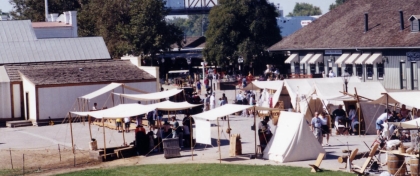"Gold Rush Days" Festival
 Annual Gold Rush Days in Old Sacramento State Historic Park Labor Day Weekend
Annual Gold Rush Days in Old Sacramento State Historic Park Labor Day Weekend
Over the four-day Labor Day Weekend 2007, the annual Gold Rush Days festival “turned back the clock,” transforming Old Sacramento into a scene from the 1850s. Costumed re-enactors, musicians playing period instruments, and many aspects of life during the Gold Rush were highlighted during the four-day event. Only horse-drawn vehicles and pedestrians were allowed in the National Landmark District and State Historic Park during this fun and festive event. Admission to the Gold Rush Days festival was free to the public.
One of the highlighted attractions of this weekend was the Embarcadero Tent City (pictured above), located at the north end of Old Sacramento and representing the first "tent city" that sprang up as the Gold Rush commenced. At the Embarcadero Tent City, guests took part in 1850s-style outdoor bowling; participated in games of chance at the Round Tent and Stinking Tent Saloons; participated in butter churning and biscuit making at the local restaurant; shop for period clothing and unique handmade wares at the general store; and toured a bathhouse where the water is changed after every tenth customer!
New to Tent City for 2007 was the introduction of a number of ethnic and cultural components (some of which were formerly presented in the “Ethnic Village” area during previous Gold Rush Days events). Selected merchants and re-enactors throughout Tent City highlighted Gold Rush era contributions to California’s rich and diverse cultural history and discuss the challenges and opportunities faced by various groups. Featured were period artifacts, storytelling, food preparation and more. Dancers and musicians performed according to long-held traditions. Among the ethnicities represented were European, Hispanic, Asian/Pacific Islander, African American and California Indian.
For guests interested in the West’s military history and its transition from lawlessness to an ordered society, Gold Rush Days offered a variety of military re-enactors, from Buffalo Soldiers to Civil War infantry groups. The event featured a “parade grounds” for mounted military units and marching units, and a grassy area where horses and pack animals were stabled, watered and fed during the weekend.
In another area of Old Sacramento, Wild West gunfights took place during the day. Although open, armed conflict was fairly uncommon on the streets of California towns during the Gold Rush, dramatic images of gunfights have been etched into our collective memories through the magic of Hollywood westerns and television shows. Trained “gunfighters” re-enacted shootouts reminiscent of old-time TV shows!
New for Gold Rush Days 2007 was a lecture series focusing on how the Gold Rush experience unfolded for various cultures and ethnicities. Also new for 2007, storytellers and docents related how emigrants traveled to California before, during and after the Gold Rush. Visitors learned how the Gold Rush and statehood inevitably led to the completion of America’s first transcontinental railroad, helping transform California into a diverse and trend-setting land of opportunity.
As visitors roamed the dirt streets and boardwalks of Old Sacramento during Gold Rush Days, they encountered horse-drawn wagons, carriages, and even a “ten-hitch” rolling along cobblestone streets, while “living history” characters stroll through town in period costume. The event included street dramas, period musicians and entertainment, wagon rides, pony rides and gold panning. Automobiles were prohibited from entering the 28-acre Old Sacramento area during Gold Rush Days, but there was plenty of nearby parking and lots of fun for the whole family.
 For more information, visit www.discovergold.org or call (916) 808-7777. View 2007 News Release
For more information, visit www.discovergold.org or call (916) 808-7777. View 2007 News Release
Gold Rush Days was produced and promoted in cooperation with the City of Sacramento, the Sacramento Convention & Visitors Bureau, California State Parks, the California State Railroad Museum Foundation, the Historic Old Sacramento Foundation, Old Sacramento Management and the Discovery Museum’s Gold Rush History Center.
